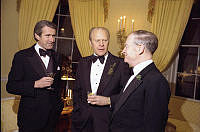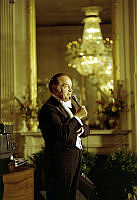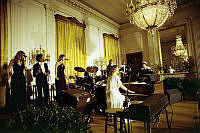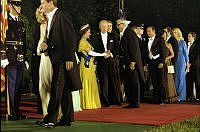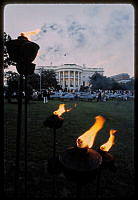Where Hospitality Makes History: State Visits
Excerpt from Life in the White House
Copyright © White House Historical Association. All rights reserved under international copyright conventions. No part of this article may be reproduced or utilized in any form or by any means, electronic or mechanical, including photocopying, recording, or by any information storage and retrieval system, without permission in writing from the publisher. Requests for reprint permissions should be addressed to books@whha.org
Since World War
II, an ever-lengthening procession of foreign leaders has come to 1600
Pennsylvania Avenue to confer on global problems. These dignitaries are often
formally entertained at the White House, and an invitation to attend such a
function is highly coveted. Certainly a State Dinner to honor a visiting head
of government or a reigning monarch is one of the most glamourous of White
House affairs, an event that also showcases global power and influence. Today
the term “State Dinner” is reserved for events in honor of heads of state,
though in the nineteenth century most official dinners, even without a foreign
official, were called State Dinners.

The United States Army Old Guard Fife and Drum Corps performs during the State Arrival Ceremony for the Republic of Korea, April 26, 2023.
Carlos Fyfe / Official White House PhotoToday’s State Dinner begins with a morning Arrival Ceremony that was first introduced by John F. Kennedy and remains largely unchanged. In his time, it also included helicopter service to transport guests to the Ellipse. Lyndon B. Johnson, Richard M. Nixon, Gerald R. Ford, and Jimmy Carter maintained the helicopter arrival, though less frequently, and the practice has now largely been abandoned. Most state guests arrive in Washington the day before and are driven through the Southwest Gate toward the white-columned South Entrance of the White House. There the president and his wife greet their guests of honor with a red carpet and often a twenty-one gun salute. The evening of the State Dinner, the president and first lady greet their guests under the North Portico and escort them to the Yellow Oval Room on the Second Floor. There they meet with other top-ranking guests, such as the secretary of state. Meanwhile, about one hundred other guests are arriving at the mansion’s east entrance. Passing through the East Wing, these guests ascend the marble stairway to the State Floor. On their way they are presented with cards explaining seating arrangements. Then they are conducted to the East Room by social aides, officers chosen from the armed forces. The president and first lady with their honored guests descend the Grand Staircase to the sounds of Ruffles and Flourishes and then greet the assembled guests in protocol order. Finally, the president and first lady escort the visitors to the State Dining Room, where the other guests await them.
Decorations and table settings for formal dinners in the White House are classic and elegant. Frequently in use is the red and gold-rimmed set of china acquired during the Reagan administration as well as the Johnson plates with wildflowers. The Clintons selected a set of gold-rimmed ivory china to commemorate the two hundredth anniversary of the White House in 2000. Laura Bush and Michelle Obama selected specially designed services to reflect their interests.

Prior to the dinner, the press is invited to a preview of the food and table settings. Executive Chef Cristeta Comerford and Executive Pastry Chef Susan Morrison explain the menu.
Associated Press / Jacquelyn MartinThe public does not have to wait long to learn details of the dinner. As an aid to the news media, Lyndon Johnson had an electronic system installed so that reporters assembled in another room could hear the traditional exchange of toasts. More recently, some foreign leaders have arranged for coverage of the dinners for later television broadcast in their home countries. News-casts and next-day newspapers often carry pictures and stories on the guests, menu, and entertainment. To obtain such information and to add firsthand descriptions to their coverage, a few White House reporters have long been permitted to attend the after-dinner entertainment and to chat with the guests.

Musician Jon Batiste performing on December 1, 2022, at a State Dinner hosted by President and Dr. Biden in honor of French President Emmanuel Macron and his wife, Brigitte Macron.
Saul Loeb / AFP via Getty ImagesBehind the glitter and ceremony of such state affairs is elaborate planning that tailors each aspect of the event to the national cultures and individual tastes of the guests of honor. These formal dinners involve the creation of guest lists, menus, flowers, table settings, and entertainment for the evening. To assure the success of the meal, the Reagans even tried out and tasted the complete dinner, down to the last detail, a week or ten days before the event.
First Lady Jill Biden has also worked closely with the White House social secretary and the Executive Residence staff to coordinate every detail for special occasions, while Executive Chef Cristeta Comerford prepares menus.




















